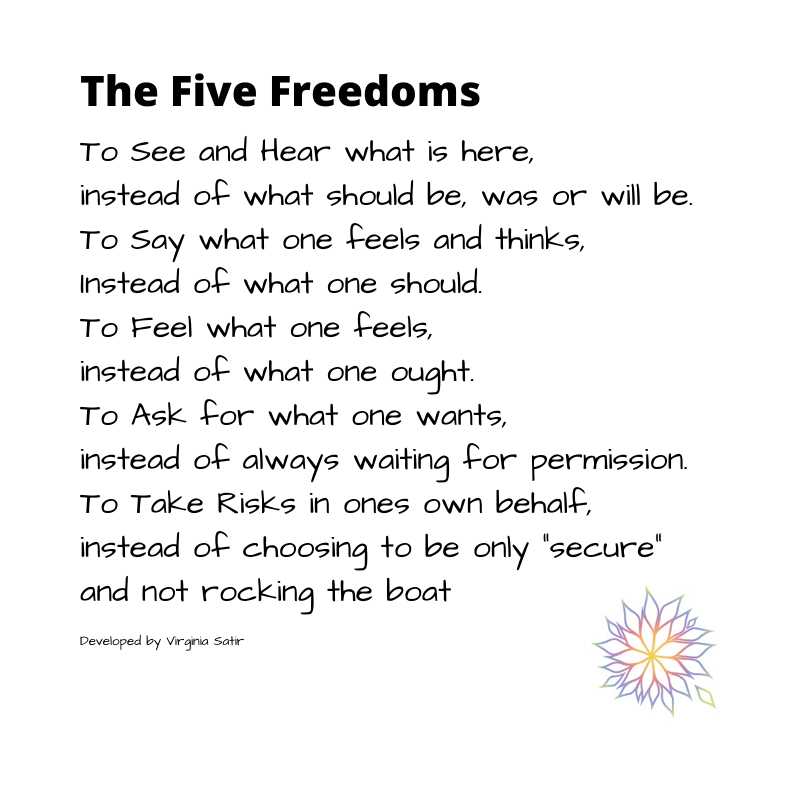
A reflection on my experience as a member of the 6-session SIP supervision group series launched February 2024
Who and what we choose to present in a scheduled clinical supervision session speaks as much about what’s happening with our client, as it does about what’s happening within ourselves as clinicians. Exploring and experiencing the self in supervision takes courage. It requires a patient, diligent, and supportive supervisory presence. These elements formed the essentials of the 6-session Satir Group Supervision program presented by Satir Institute of the Pacific in February 2024. I was one of six participants who met bi-weekly, logging in from different time zones to meet online together with our supervisors, Tricia Antoniuk and Linda Lucas. Both seasoned Satir practitioners and SIP trainers, Trish and Linda set a course for us to navigate around a key question: Can we stay curious about you? The question served as a kind of navigational beacon, evoking an introspective turning about. When the question met with struggle, our supervisors remained solidly anchored in Satir process and threw us a lifeline: Is there a part of you that can stay curious? What does that part need?” I found these gentle but firm requests were helpful in summoning the courage needed to undertake the wide, arching turn into the deeper waters of the self, to feel the force of yearnings charging at me like a spring tide, and find anchorage in the safe harbour of resources that might otherwise stay hidden from view. Looking through my own lens as a supervisee, the question and many others drawn from the depths of Satir process encouraged us to connect with shared courage across time zones and cultures from which we hailed (Singapore, China, Thailand, America, Canada) as we endeavored to explore the depths of our own, and our clients’ personal icebergs. I felt encouraged to make the best use of myself, and accept Linda’s invitation expressed to all that being triggered by our clients only brings about more opportunities to practice. I’m encouraged to make use of my own inner conflict to help my clients give voice to their needs, to engage them in an experiential exchange, to push at the boundaries of fear, and to explore the resource-rich territories of self from which we might chart a new course for change.
My experience of turning back toward self in this supervision was through an all too familiar portal — my own fear of loss. There is a part of me that struggles to act “as if” this fear is not so acute. It’s even so bold at times as to assume it’s resolved. In this group, and in other work I completed in the foundations of Satir Levels I and II, I’ve come to understand this as a place in my mind where this part of my self likes to roost, for a spell, in the comfortable acts of thinking and reasoning. There is a case to be made (largely by fear) to remain there, applying reason and logic to reality-test beliefs about life, love, and change. No matter how much training I do, the promontory of Socratic dialogue stands between harbour and horizon as I undertake each new client journey. It takes a conscious slowing down, an easing off, a glance across my desk at the drawing of the iceberg or, in the case of this supervision group, a question quietly, and gently repeated – can we stay curious about you? My supervisor, Tricia, made ample use of this question to evoke my own and others’ curiosity, to summon the superpower of the knowledge-seeking self. She watched and waited, holding the silence between us with humble patience while I found the courage to move to the deeper, darker waters of self. I feel tears rising from that place below the water line of my personal iceberg where fear resides. Curiosity gives me the buoyancy I need in this place to peer more confidently into the darker depths of expectation, of judgement, and perception. I speak my fears out loud: “I’m afraid she (referring to my client) will give up.” Hearing my words spoken out loud I realize I’m afraid to ask for more, afraid to push too much or too fast. I’m plotting a course below that waterline where the deep waters of the client and my own self merge. Occupying very different roles in this voyage as client and therapist, we’re both nonetheless summoned by a clarion signal of fear — to respond, react, alter course, even to call for help. We have choices. This is not a place of stillness.
Right now
My tears
Are
Falling
The Iceberg is
Melting
-excerpted from “Insights” “Call me an Angel” by Linda E. Roberts
In this moment of supported intrapsychic exploration an image rises from my mind’s eye of my mother. Tears spill down my cheeks as I recall a younger me who found herself marooned by seemingly unnavigable challenges at earlier times in my life. The person who didn’t push but found a way to nudge me forward, often by speaking openly against my own doubts, was my mother. She died just a month before this supervision group started. My last visit with her was spent holding her hands, whispering my quiet, heartfelt words of gratitude to her on what was her last full day of life. Now, in this supported, quiet exchange of self and supervisor it’s my mother’s voice that penetrates the depths to boldly speak against those things fear has me believing about myself that are not true — that I can’t take risks, that I can’t face this new challenge. I’m reminded now that doubts about self and fears about further loss conspire to form a boundary between my client and her own yearnings (for connection, for acceptance). The same feelings of fear and doubt surface in our sessions. I see them now as a means by which this boundary may be safely and supportively navigated. Now, with the gentle nudge of my supervisor, — what do you want to do with this? What does this need? a widening circle of light illuminates the boundary. And, within this ever expanding circle, a connecting point emerges. Witnessed by the quiet attentiveness of the other five group members, and inspired by their own courageous dives below the waterline of their personal icebergs, we arrive at a conclusion that this is my own fear meeting up with that of my client. We share a fear of loss and this shared experience represents a frontier for further exploration. I’m supported to make use of this connection because it represents both the possibility of positive, life-affirming change, and the inevitability of yet more loss. These experiences stand as essential parts of knowledge that connect us – the combined forces of possibility and pain. I’m reminded that in exploring my own self, visiting that broad estuary where fear is transformed with curiosity evoked by a patient questioner, I can move from the shallows into a deeper place of knowing and experiencing life as a vulnerable but wise traveller, subject to the vagaries of life. I can return to this client and meet her fears with my own resources.
In this supervision where I am supported to navigate the depths of my own personal iceberg, I see fear now as a signal for both caution and possibility. This is made all the more clear in this moment between self and supervisor. I can use the connection with fear to meet my client with renewed hope that together we can chart a course of faith and possibility in her life. I can trawl for resources together with a supportive and patient supervisor whose diligence helped me resurrect a precious relic of support in my own life. I can ask my client to pause in her own deep waters of self to find those supportive others who might speak openly against what she’s believing about herself when she confines herself to the shallows. I can invite her to let these other voices and views come to the surface of her mind where beliefs can be made to meet up with what’s known, what’s felt, and what’s possible with the love and confidence of her important others.
Maureen Manning is a counsellor and clinical supervisor in private practice.
Sources/References:
Satir Group Supervision communications Feb. 6, March 5, March 19, April 2, April 16 2024
Sample Iceberg Process Questions Of the Satir Model, A Beginner’s Manual by Dr. John Banmen
The Satir Model, Family Therapy and Beyond, Virgina Satir, John Banmen, Jane Gerber, Maria Gomori
Therapists’ Experience Using Satir’s Personal Iceberg Metaphor, Wendy Lum, MA, RCC, RMFT in the Satir Journal: Transformational Systemic Therapy Vol. 2 No. 2, 2008
“Insights” “Call me an Angel” by Linda E. Roberts in The Satir Journal: Transformational Systemic Therapy Vol. 2 No. 2, 2008
Competency-based Supervision – BCACC/BCPA Clinical Supervision Workshop presented June 15 2023 by Carol Falender PhD


